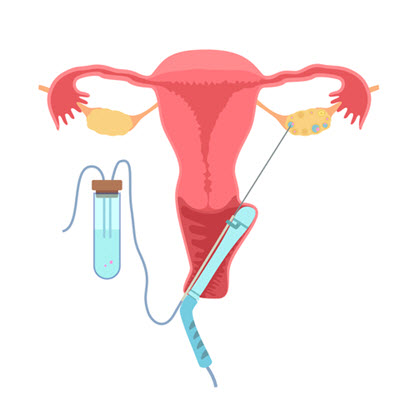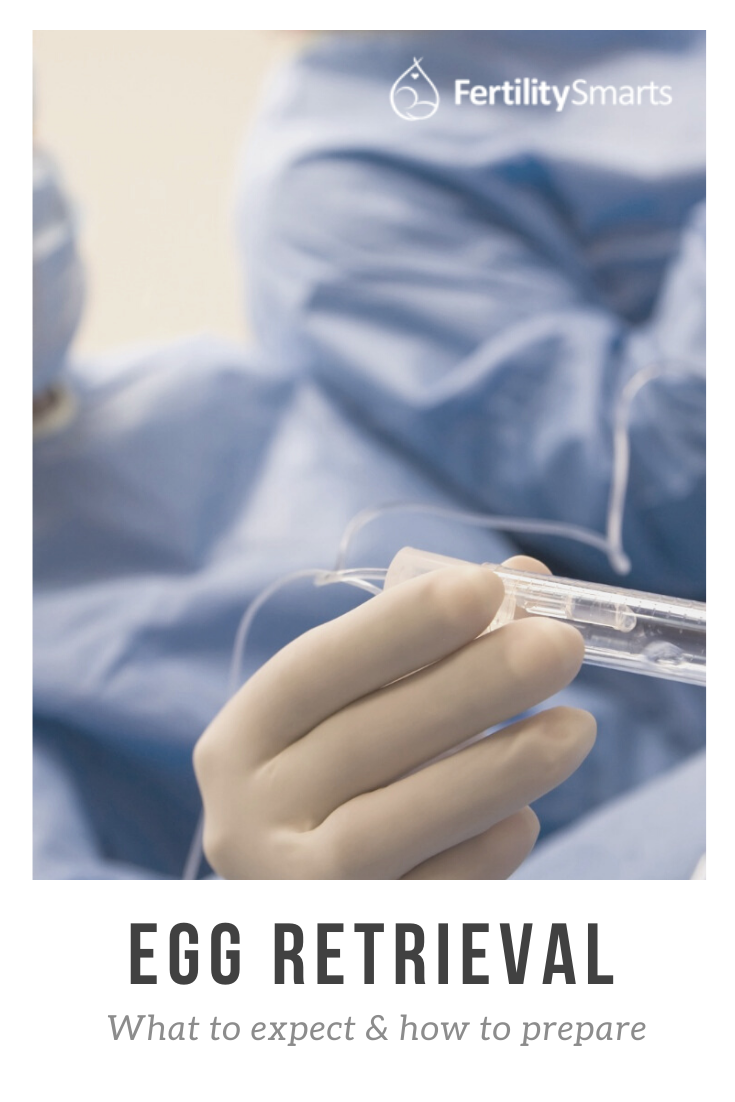In vitro fertilization (IVF) can be overwhelming, but the egg retrieval, also known as egg harvesting or egg collection, doesn’t have to be. After all the preparation with the appointments, pills, shots, and ultrasounds, you're finally getting ready to see what happens next. Here’s what you can expect from an egg retrieval procedure.
What is an Egg Retrieval Procedure?
The IVF cycle is basically a zuped up menstrual cycle. What exactly does that mean? In a natural menstrual cycle, hormones called gonadotropins are released from the pituitary gland and help recruit one egg to mature over about 10-14 days and then signal ovulation (egg released from the ovary into the fallopian tube where hopefully it meets sperm).
The medications in an IVF cycle are simulating the natural recruitment process with the goal of recruiting more than one egg. Retrieving multiple eggs increases the likelihood of having high-quality embryos to transfer back to the uterus.
Essentially, the egg retrieval is like ovulation; however, there are more eggs involved and they are retrieved out of the body before they would ovulate on their own inside the body.
If a patient does not have a fresh embryo transfer, they can expect a menstrual period about 7-10 days after the egg retrieval and the ‘cycle’ is then complete.
Preparation for IVF Stimulation
Most IVF stimulation protocols start with some sort of medication to prepare the eggs and the most common is the birth control pill. Patients are often shocked when I tell them that the first step in IVF is taking birth control pills and they often say, “Isn’t that the opposite of what we’re trying to do here?” I then joke, “We need to re-brand them, no one would hesitate if I call them ‘IVF prep pills.’
The birth control pills are meant to prepare the eggs for recruitment. I describe it as getting them on the starting line for stimulation so that they all develop at the same rate and most of them will be mature and ready for retrieval at the same time.
Other ways to prep for the stimulation phase of IVF can be:
- Estrace (estrogen-only pill)
- Lupron (a daily shot)
- Sometimes your provider may recommend stimulation without preparation. This can mean starting daily stimulation shots with the onset of a period and can be called a spontaneous start IVF cycle.
Suppression Check and Breakthrough Ovulation
Before you start the stimulation medication, you’ll have an appointment (often called a suppression check) to check that you are ready. This usually involves an ultrasound and a blood test for estradiol (an estrogen that your ovaries produce).
Occasionally people breakthrough birth control pills and other preparation medications, and if so, we do not recommend starting the cycle. Breaking through birth control pills means recruiting an egg while on birth control pills and we can tell this happens if there is a large follicle on the ultrasound in combination with a higher than expected estradiol level on the blood test.
It is very frustrating to be ready for your IVF cycle and have it delayed but it’s the right thing to do. If we started the stimulation shots when your body has already selected an egg to start recruiting, then that is the only one that would develop to maturity in that cycle and the whole point of IVF is to recruit more than one egg.
If the ovaries are quiet and the estrogen level low, you are ready to start the stimulation phase of the IVF cycle!
Stimulation Phase of IVF
Let’s take the mystery out of the IVF cycle — it’s not magic recruiting eggs—it’s science. Every menstrual cycle women may ovulate one egg but many more eggs are lost (this happens every month whether or not we are having menstrual cycles).
Our eggs are constantly trying to develop and then the vast majority die off (I wish we could put a pause button on this process!). Of all the eggs that we lose each month, a small group of them are recruitable (able to respond to stimulation medication, if given).
In a natural cycle, the pituitary gland makes enough gonadotropins, mostly follicle-stimulating hormone (FSH), to recruit one egg and when the ovaries make enough estrogen to signal that the egg is mature the pituitary gland produces a surge of another gonadotropin, luteinizing hormone (LH) which induces ovulation of that mature egg.
We are mimicking this process in IVF with the goal of recruiting more than one egg. We give gonadotropins for 10-14 days in the form of shots to recruit the eggs that are available. These shots are the same hormones a woman’s body makes each month, just in higher doses.
It’s important to know that every woman is different, and every cycle is different. The same dose of medications can produce a different number of eggs in different women and even in the same woman but over different menstrual cycles.
Women are followed closely throughout the cycle with ultrasounds (follicle sizes increases as eggs mature) and blood tests (estrogen levels increase as eggs mature).
Ovulation Suppression
The medications you take in your IVF cycle are not all stimulation. Another medication will usually be given to prevent ovulation before the egg retrieval. This medication is either leuprolide (Lupron) or an antagonist medication (Ganirelix or Cetrotide).
Daily Lupron shots are started before the stimulation medications and given throughout the cycle while antagonist shots are usually only taken 4-5 days before the egg retrieval. The goal of IVF is to retrieve the eggs when the majority of them are mature and so it is a balance between stimulation and preventing ovulation.
Ready Set, Trigger Shot Time!
When your doctor feels that the majority of the eggs are mature and you’re ready for retrieval, you'll do one last shot to trigger the final maturation of the eggs. This ‘trigger shot’ is mimicking the LH surge that occurs in the middle of a natural cycle once the ovaries give the signal that the egg is mature and ready for ovulation.
In an IVF cycle, you’re taking a medication to prevent this ovulation signal (like leuprolide or an antagonist medication) so you shouldn’t ovulate on your own.
The trigger shot is a very important part of the IVF cycle. The timing of the shot is determined by when the retrieval is scheduled. Your provider is timing when the eggs will be mature and almost ready for ovulation but not quite ovulation because we want to get those eggs first!
If you do not take your trigger shot the doctor will not get eggs at the retrieval. If you take it too early or too late, please let your doctor know because it will impact the success of the egg retrieval.
The Egg Retrieval Procedure Step-By-Step
It is usually a simple procedure that takes about 15-20 minutes. Every clinic is different and every patient’s needs are unique but most will provide sedation to make you comfortable and even asleep during the procedure. You can expect to be asked to not drink or eat anything for hours before coming to the clinic, changing into a gown, getting an IV in your arm, and meeting a few new people that day.
The procedure itself is done vaginally. There are no incisions or stitches that have to be removed.
While you are asleep, the doctor does a transvaginal ultrasound and guides a needle into the ovaries where the eggs are kept inside the follicles (fluid-filled structures in the ovaries). The needle goes through the upper wall of the vagina right into the ovary and drains each follicle.
The eggs come with the follicle fluid through the needle, through the tubing, and into a test tube (hence the term ‘test-tube baby’). This tube is then given to an embryologist who looks through the follicular fluid to find the eggs.
The eggs are microscopic and surrounded but supporting cells and other material from the follicles. The embryologist gently isolates the eggs and placing them into a Petri dish with media (a special liquid solution) for safekeeping in a warm (body temperature) incubator.

Usually, you will wake up in the recovery room feeling a little sleepy and have some cramps but otherwise feeling OK. You will leave the clinic knowing how many eggs were retrieved. Be sure to ask when to expect your next update.
Egg Retrieval Tips
- Follow all directions from the clinic regarding the timing of the trigger shot and call if anything goes wrong or if you have any questions.
- Relax and try to get some sleep the night before the retrieval.
- Follow directions from the clinic the morning of the retrieval (like nothing to eat or drink.)
- Get to the clinic on time for the retrieval. Plan for traffic or weather conditions; consider staying close to the clinic the night before if you’re worried for any reason.
- Be honest with the people caring for you on the day of the retrieval. Let them know if you are nervous. Ask if you’ll see your doctor before or after the procedure.
- If you’re worried about something — ask!
- Consider your mindset that day:
- Think of the egg retrieval as a test you’ve studied for and you cannot do anything else for. You’ve done all the preparation, taken all the shots, when you’re at your appointment, take comfort in that.
- Practice gratitude — remind yourself of all the hurdles it took to get to the retrieval and be thankful that your body responded to the medications and that you’ve made it to this goal.
- Consider meditation or visualization. If you can choose music, ask for it or bring headphones. If you have a happy place (like a beach) imagine yourself there as you’re relaxing off to sleep.
-
Plan for after the retrieval. Make it a you day! Think couch, pillows, warm blankets, and a lineup of movies and shows you want to catch up on. Comedy recommended! Plan for your favorite meal and pamper yourself!
